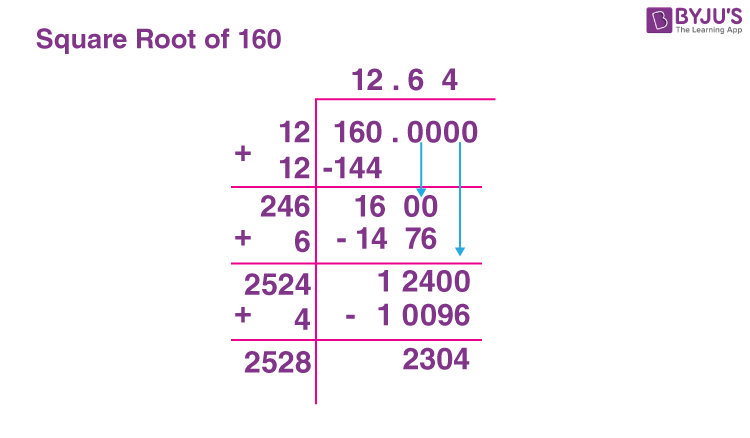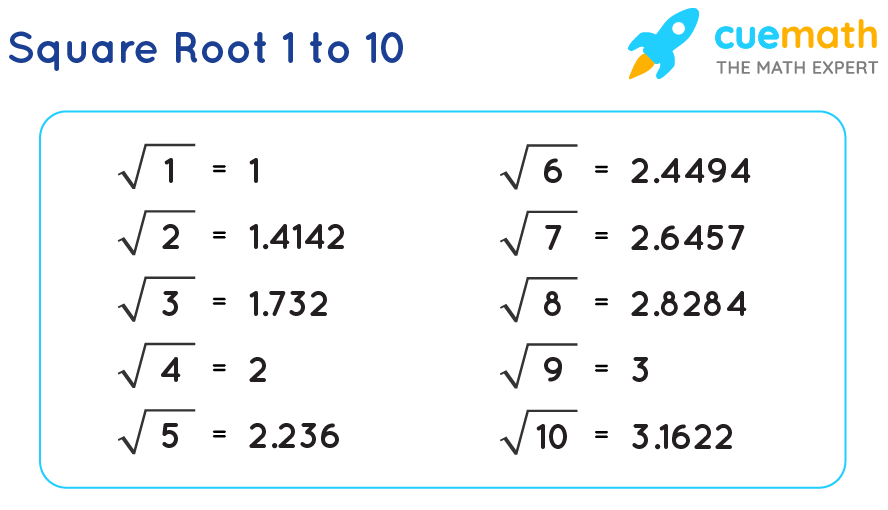Topic is the square root of 16 irrational: The question "Is the square root of 16 irrational?" often arises in mathematical discussions. In this article, we'll explore the nature of the square root of 16, understand its properties, and explain why it is classified as a rational number. This explanation will help clarify the concept for both students and enthusiasts.
Table of Content
Is the Square Root of 16 Irrational?
The square root of 16 is a well-known mathematical value, and understanding its properties can help clarify whether it is rational or irrational.
Definition and Calculation
The square root of 16 is represented as \( \sqrt{16} \). To find this value, we look for a number which, when multiplied by itself, gives the product 16. This number is 4, since:
\[ 4 \times 4 = 16 \]
Hence, \( \sqrt{16} = 4 \).
Rational vs. Irrational Numbers
Rational numbers are numbers that can be expressed as the quotient or fraction of two integers (i.e., \( \frac{p}{q} \), where \( p \) and \( q \) are integers and \( q \neq 0 \)). Irrational numbers, on the other hand, cannot be expressed as such fractions.
Classification of the Square Root of 16
Since 4 can be written as \( \frac{4}{1} \), it is a rational number. Therefore, the square root of 16 is rational.
Perfect Squares and Rationality
16 is a perfect square (i.e., it can be expressed as \( 4^2 \)). The square roots of perfect squares are always integers, which are rational numbers. Hence:
\[ \sqrt{16} = 4 \]
is a rational number.
Examples and Applications
- Example 1: If a square table has an area of 16 square inches, the length of each side is 4 inches (since \( \sqrt{16} = 4 \)).
- Example 2: To determine the number of cubes on each side of a square arrangement of 16 cubes, we find that each side has 4 cubes (since \( \sqrt{16} = 4 \)).
Conclusion
The square root of 16 is 4, which is a rational number. Therefore, the square root of 16 is not irrational.
| Number | Square Root | Rational/Irrational |
|---|---|---|
| 16 | 4 | Rational |

READ MORE:
Introduction
The square root of 16 is a fundamental concept in mathematics, widely applicable in various fields. Understanding whether it is rational or irrational helps to deepen our comprehension of number theory. The square root of 16 is commonly questioned, yet its nature is straightforward when examined closely.
- The square root of 16, represented as √16, equals 4.
- It falls under several sets of numbers: natural numbers, whole numbers, integers, rational numbers, and real numbers.
- Since 4 is a whole number and can be expressed as a fraction (4/1), √16 is considered rational.
- Multiple methods can be used to calculate √16, including the guess and check method, prime factorization, and using calculators.
- Knowing the square root of 16 is crucial in practical applications such as geometry, where it helps determine the lengths of sides of squares and rectangles.
This exploration will walk you through the details, showing why the square root of 16 is rational and how it can be computed using different methods.
Definition of Rational and Irrational Numbers
To understand whether the square root of 16 is rational or irrational, it's essential to grasp the definitions of rational and irrational numbers.
What is a Rational Number?
A rational number is any number that can be expressed as the quotient or fraction p/q of two integers, where p and q are integers and q is not zero. In other words, a rational number can be written in the form of a fraction, where both the numerator and the denominator are whole numbers.
- Examples of rational numbers include:
- \( \frac{1}{2} \) (one half)
- \( \frac{4}{5} \) (four fifths)
- \( 2 \) (which can be written as \( \frac{2}{1} \))
- \( -3 \) (which can be written as \( \frac{-3}{1} \))
What is an Irrational Number?
An irrational number is a number that cannot be expressed as a simple fraction - it cannot be written as the quotient of two integers. Irrational numbers have non-repeating, non-terminating decimal expansions.
- Examples of irrational numbers include:
- \( \sqrt{2} \) (the square root of 2)
- \( \pi \) (pi, the ratio of a circle's circumference to its diameter)
- \( e \) (Euler's number, the base of the natural logarithm)
- \( \sqrt{3} \) (the square root of 3)
Comparison Table
| Rational Numbers | Irrational Numbers |
|---|---|
| Can be written as a fraction \( \frac{p}{q} \) where \( p \) and \( q \) are integers and \( q \neq 0 \) | Cannot be written as a fraction \( \frac{p}{q} \) where \( p \) and \( q \) are integers |
| Decimal form is either terminating or repeating | Decimal form is non-terminating and non-repeating |
| Examples: \( \frac{3}{4}, 0.75, 2, -5 \) | Examples: \( \sqrt{2}, \pi, e \) |
Square Root of 16
The square root of 16 is a fundamental concept in mathematics, illustrating how to determine the original number that, when multiplied by itself, results in 16. The calculation and interpretation of square roots can be approached in various ways, including the prime factorization method, long division method, and repeated subtraction method.
Basic Concept of Square Roots
The square root of a number \( x \) is a value \( y \) such that \( y \times y = x \). For 16, the square root is the number that, when multiplied by itself, equals 16. This can be represented as:
\[\sqrt{16} = 4 \quad \text{since} \quad 4 \times 4 = 16\]
Prime Factorization Method
The prime factorization method involves breaking down 16 into its prime factors and pairing them to simplify the square root.
- Prime factorize 16: \( 16 = 2 \times 2 \times 2 \times 2 = 2^4 \)
- Group the prime factors into pairs: \((2 \times 2) \times (2 \times 2)\)
- Take one number from each pair: \(2 \times 2 = 4\)
Thus, \(\sqrt{16} = 4\).
Long Division Method
The long division method is another systematic way to find the square root. Here are the steps:
- Write 16 and pair the digits from right. Since 16 has only two digits, it forms one pair.
- Find the largest number whose square is less than or equal to 16. This number is 4.
- Divide 16 by 4 to get the quotient 4. Thus, \(\sqrt{16} = 4\).
Repeated Subtraction Method
Although less common, the repeated subtraction method can also be used:
- Subtract consecutive odd numbers from 16 until you reach zero.
- Count the number of subtractions. Here’s how it works for 16:
- 16 - 1 = 15
- 15 - 3 = 12
- 12 - 5 = 7
- 7 - 7 = 0
- Since we subtracted 4 times, \(\sqrt{16} = 4\).
This method illustrates that after four steps of subtracting consecutive odd numbers, we reach zero, confirming the square root of 16 is 4.
Conclusion
From the methods outlined above, it is clear that the square root of 16 is 4. This value is a rational number, as it can be expressed as an integer.
Is the Square Root of 16 Rational?
The square root of 16 can be determined as a rational number through several methods. Here, we will discuss the prime factorization method, why the square root of 16 is rational, and provide mathematical proofs.
Prime Factorization of 16
To understand why the square root of 16 is rational, we start with its prime factorization:
- 16 can be expressed as \( 2^4 \) (since \( 2 \times 2 \times 2 \times 2 = 16 \)).
- When taking the square root of 16, we get:
- Since 4 is a whole number, the square root of 16 is rational.
\[
\sqrt{16} = \sqrt{2^4} = 2^2 = 4
\]
Why the Square Root of 16 is Rational
A rational number is any number that can be expressed as a fraction of two integers. The square root of 16 is 4, which can be written as \(\frac{4}{1}\). Thus, it fits the definition of a rational number:
- 4 is an integer.
- 4 can be expressed as a fraction (e.g., \(\frac{4}{1}\)).
- There are no repeating or non-terminating decimals involved.
Mathematical Proofs
There are several ways to prove that the square root of 16 is rational:
- Direct Calculation:
Calculate the square root directly:
\[
\sqrt{16} = 4
\] - Long Division Method:
Using the long division method, we find that the quotient obtained is 4, confirming the result.
- Exponentiation Method:
Express 16 as an exponent and apply the square root:
\[
\sqrt{16} = (16)^{\frac{1}{2}} = (2^4)^{\frac{1}{2}} = 2^2 = 4
\]
Therefore, through these various methods, we can conclusively determine that the square root of 16 is a rational number.

FAQs
Here are some frequently asked questions about the square root of 16:
-
What is the Value of the Square Root of 16?
The square root of 16 is 4. This is because \(4 \times 4 = 16\). Symbolically, it is represented as \( \sqrt{16} = 4 \).
-
Is 16 a Perfect Square?
Yes, 16 is a perfect square. A perfect square is an integer that can be expressed as the product of an integer with itself. Since \( 4 \times 4 = 16 \), 16 is a perfect square.
-
Why is the Square Root of 16 a Rational Number?
The square root of 16 is a rational number because it can be expressed as a fraction of two integers. Since \( \sqrt{16} = 4 \) and 4 can be written as \( \frac{4}{1} \), it fits the definition of a rational number.
These explanations provide clarity on why the square root of 16 is an important and straightforward mathematical concept.
READ MORE:
Khám phá bản chất của căn bậc hai của 16 và tìm hiểu xem nó có phải là số vô tỷ hay không.
Căn bậc hai của 16












